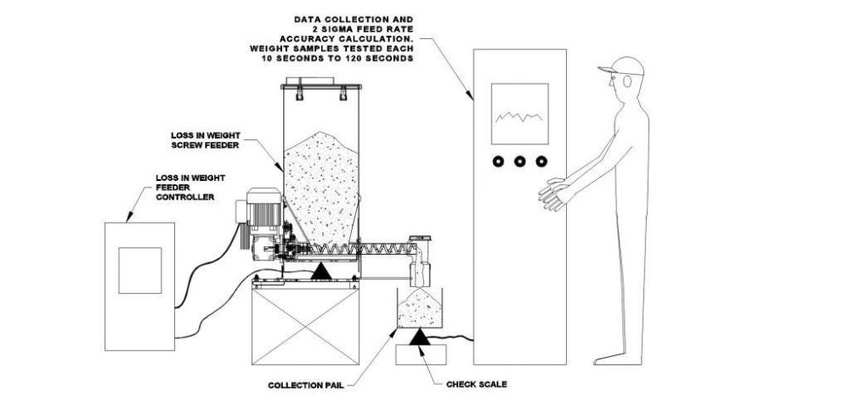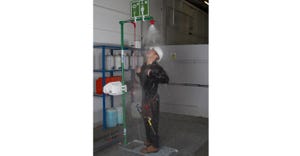Checking Loss-in-Weight Feeder Accuracy Online without Interrupting Production
March 23, 2017

A loss-in-weight feeder incorporates a feeder mounted on a scale. The feed rate is controlled by a weight feedback signal using a microprocessor-based controller that compares feed rate set point to the weight loss over short precise time periods to control the feed rate at set point. The weight loss is the ingredient being feed out of the feeder and being measured by the scale.
Prior to purchasing loss-in-weight feeders, potential users often visit feeder manufacturers with the ingredients to be fed. The manufacturer selects the most reliable feeder type, agitation/conditioning method, and capacity of equipment to meter the ingredient at the required feed rate. The schematic below shows a typical feed rate accuracy set up used by the manufacturer, often with user present to check the feed rate accuracy.
(See Schematic 1)
The feed rate accuracy test normally uses a procedure of weighing 30 or more consecutive feed rate samples (over 15-second to 60-second intervals). The samples (continuous feed stream of the ingredient) are normally taken by using a collection bucket mounted on a scale and connected to a computer that records the weight changes at precise time intervals during the test. The computer calculates the feed rate of each sample. The data collected is analyzed using 2 sigma statistical analysis and feed rate accuracy (repeatability) is determined from this analysis. A 2 sigma analysis predicts that future results under the same conditions will produce a feed rate accuracy within the 2 sigma value for 95.45% of future such feeding samples. Part of the 2 sigma calculations is to determine the “mean” of the data points. The mean should be equal to the set point to within very close tolerances. The feeder is then selected based upon feed rate reliability and accuracy.
Click here for information about the PBS Toronto event, May 16-18, 2017
Important to understand is that the samples are collected from the feeder and weighed under ideal conditions. Vibration (e.g. personnel movement) and air currents have been reduced to a minimum. Feeder refill is often performed manually (dumped into feeder hopper by hand). The samples are often taken without feeder flexible connections, including refill valve, feeder discharge tube, and the refill dust collector (if not feeder mounted) connected.
This testing also produces important information that is useful for future accuracy testing during production, such as optimal screw diameter and pitch (assuming the feeder is a screw feeder), screw speed at each feed rate tested, and the change in screw speed versus feeder weight change during the trial.
After feeders have been delivered, the next step is to place the feeders into production. It is recommended that a service technician from the feeder manufacturer be present at initial start-up to insure both proper installation of equipment and subsequent operation. The service personnel will operate each feeder to ensure that each is feeding and measuring accurately by performing a feed rate test as described below for the installation.
The production setup looks much different from the loss-in-weight feeder accuracy test setup. The schematic below shows a typical production setup.
(See Schematic 2)
In production, the feeders typically include flexible interconnections to make them dust tight, arranged for auto refill, and include dust containment accessories.
Feed rate accuracy testing in production is often performed by shutting the line down, exposing the feeder outlet tube, and placing a collection container beneath this outlet tube. The feeder is then operated. A timed sample is collected and then placed on a scale to be weighed. With this method, the feed rate calculation will not be as precise as the calculation previously done in the feeder manufacturer’s performance test lab.
As an alternative to this method of checking feed rate accuracy, feeder manufacturers have developed an online, in production method. The controllers being provided with the feeders today are equipped with feed rate test capabilities.
With the feeder operating normally in production, the test function is selected and the display on the controller will display the test feed rate. The conditions necessary for doing this type of test are as follows:
1. The feeder scale has been checked for accuracy when the feeder is turned off. Normally the feeder scale is checked with calibrated weights over the scale range (three weighments are normally acceptable).
2. The test time is selected, normally 15 seconds to 2 minutes.
3. A refill does not occur during the test. It is necessary to have an uninterrupted weighment.
4. Document the screw speed during the test. If the tested feed rate is incorrect, the source of the error has to be found. This is where the 2 sigma test data is used to help find the error.
The previously obtained 2 sigma test data is compared to the data collected during production teat. The screw size (diameter and pitch) and screw speed for the same feed rates are compared. If there is an error, the screw speeds will have differences.
In order to achieve high feed rate accuracy at a selected feed rate, the screw speed should not fluctuate during the testing.
If the screw speed is fluctuating during the production test, it is normally caused by:
1) An uneven filling of each screw flight with ingredient
2) A leaking refill valve letting a small random flow of ingredient into the feeder when the valve is closed
3) Air pressure from the dust collection system or from the transfer system refilling the feeder or from a fluctuating pressure in the downstream process
4) The feeder weight is fluctuating due to a random movement of the scale (a nearby fan for example)
5) The flexible connections could be installed incorrectly causing a fluctuating force on the scale. This would be evident during the scale check with the feeder off.
Conclusion
Online feed rate accuracy tests without interrupting production are available today and have proven to be a valuable tool to the processor. In order to maximize the benefits of this tool, 2 sigma testing prior is recommended as the data obtained from this test is quite useful to determine the reasons for any feeder inaccuracies during the production process.
Walter Folkl is sales manager at Brabender Technologie Inc., Mississauga, Ontario, Canada. For more information, call 905-670-2933 or visit www.brabenderti.com.
For related articles, news, and equipment reviews, visit our Feeders Equipment Zone
You May Also Like


